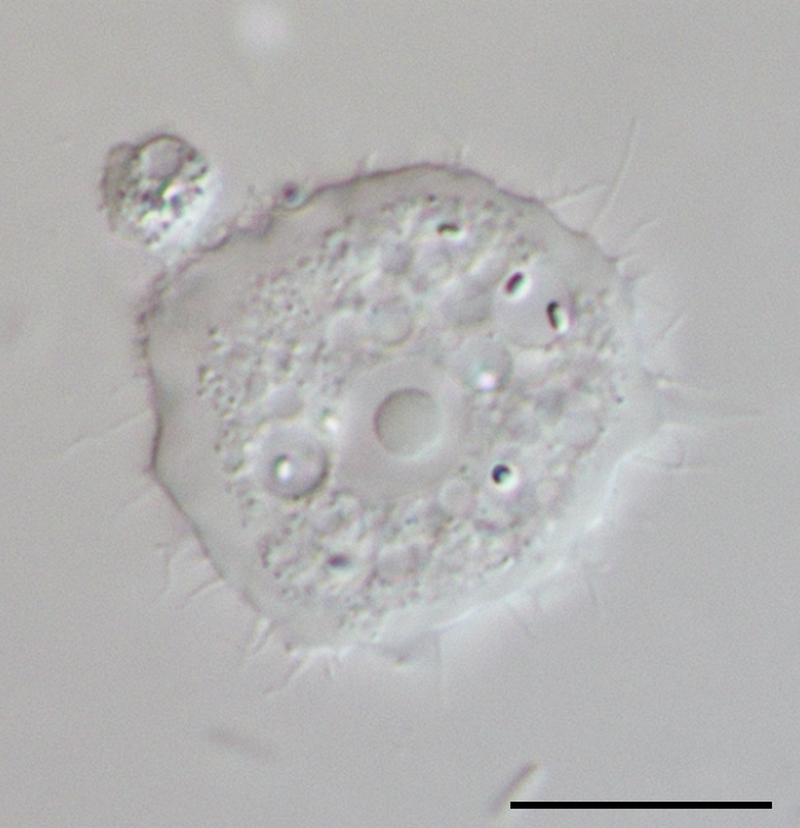 |
| Plasmodium falciparum, protozoan that causes malaria in humans |
According to the World Health Organization (WHO), in the year 2015 there were about 214,000,000 cases of malaria, a disease caused by the protozoan Plasmodium, which killed 438,000 people. Leishmaniasis, caused by the protozoan Leishmania is a disease that affects dogs and humans, causes severe ulcers on the skin leaving scars for life. The trichomoniasis, a sexually transmitted disease, is caused by the protozoan Trichomonas vaginalis. Some sources estimate an incidence of 70% in populations of developed countries, with no symptoms or sporadic symptoms such as itching or pain in sexual intercourse. These are just some examples of the importance of parasites in human health. And this without mentioning the importance in animal health, both in the animals that surround us, and in the livestock economy.
The identification of the parasite is fundamental for the correct diagnosis of the parasitosis. This requires a training in microscopic staining and identification techniques, and in some cases additional tests, such as the ELISA test.
Background
- Reading: Austin Community College. Medical Parasitology. Lab Manual ( LABORATORY EXERCISE 3: Identification of Parasites)
Procedure
Microscopic identification techniques for protozoan parasites are complex and require specialized training.
This experiment will focus, not on the manipulation of the samples, nor on the microscopic techniques of preparation and staining, but on the identification of protozoan parasites through microscopic observation. For this, a series of intestinal protozoan parasites will be observed under the microscope.
- Reading: M. Arcari, A. Baxendine and C. E. Bennett. Diagnosing Medical Parasites Through Coprological Techniques: Volume 1 The Amoebae See Below, Volume 2. The Ciliates, Coccidia and Microsporidia, Volume 3. The Flagellates
Ways to perform the experiment
1. In Laboratory
The laboratory that performs experiments and tests of parasitic protozoology, must have a supply of samples, adequate instruments and staff training. If this is not possible, microscopy preparations can be acquired. One microscopy preparation of parasitic protozoa usually cost about 8-10 $.
2. In Home Lab
In principle, the experiment is not dangerous if carried out with commercial microscopic preparations. For the experiment it is necessary to have a microscope something better than a toy. There are possibilities for setting up a low cost home microscopy lab (in spanish).
3. Virtually
For this purpose, microscopic images of parasitic protozoa can be made in the same post in the next section.
Microscopic images of protozoan parasites
Click on the image to enlarge.
 |
| Entamoeba histolytica |
 |
| Acanthamoeba |
| Trichomonas vaginalis |
 |
| Tripanosoma cruzi |
 |
| Plasmodium falciparum |
 |
| Toxoplasma gondii |
 |
| Leishmania donovani in bone marrow cells (in the center) |
 |
| Babesia |
Giardia lamblia
Pentatrichomonas hominis, fresh analysis of human feces
Trichomonas vaginalis, thawed after freezing
Questions and activities
1.- Draw the observed protozoa.
2.- Make a table or diagram of identification of the observed protozoa.
3.- Indicate the identifying characters of each protozoan observed, a small description and their parasitological importance.
4.- Search the Internet for images of protozoan parasites.
5.- Enter into the website Protist Image Data, access the database of protists, identify protozoan parasites and access their images and data (the website has some years and there are several broken links).
Resources for further learning
- Reading: World Health Organization. Basic laboratory methods in medical parasitology (pdf)
Spanish version of this page
Parasitology
Trichomonas vaginalis, thawed after freezing
Questions and activities
1.- Draw the observed protozoa.
2.- Make a table or diagram of identification of the observed protozoa.
3.- Indicate the identifying characters of each protozoan observed, a small description and their parasitological importance.
4.- Search the Internet for images of protozoan parasites.
5.- Enter into the website Protist Image Data, access the database of protists, identify protozoan parasites and access their images and data (the website has some years and there are several broken links).
Resources for further learning
- Reading: World Health Organization. Basic laboratory methods in medical parasitology (pdf)
Spanish version of this page
Parasitology







0 comentarios:
Publicar un comentario